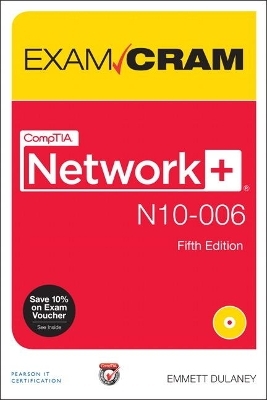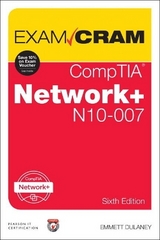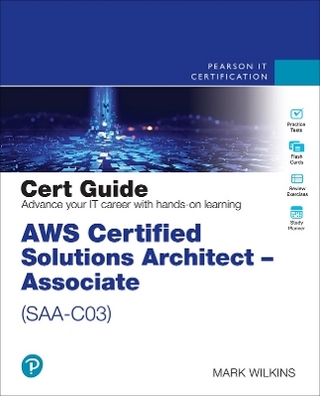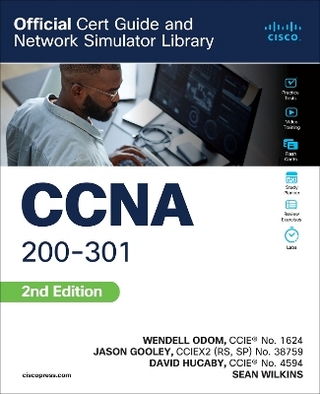
CompTIA Network+ N10-006 Exam Cram
Pearson IT Certification
978-0-7897-5410-3 (ISBN)
- Titel erscheint in neuer Auflage
- Artikel merken
CompTIA® Network+ N10-006 Exam Cram, Fifth Edition is the perfect study guide to help you pass the CompTIA Network+ N10-006 exam. It provides coverage and practice questions for every exam topic, including substantial new coverage of security, cloud networking, IPv6, and wireless technologies. The book presents you with an organized test preparation routine through the use of proven series elements and techniques. Exam topic lists make referencing easy. Exam Alerts, sidebars, and Notes interspersed throughout the text keep you focused on what you need to know. Cram Quizzes help you assess your knowledge, and the Cram Sheet tear card is the perfect last-minute review.
Covers the critical information you’ll need to know to score higher on your CompTIA Network+ (N10-006) exam!
--Understand modern network topologies, protocols, and infrastructure
--Implement networks based on specific requirements
--Install and configure DNS and DHCP
--Monitor and analyze network traffic
--Understand IPv6 and IPv4 addressing, routing, and switching
--Perform basic router/switch installation and configuration
--Explain network device functions in cloud environments
--Efficiently implement and troubleshoot WANs
--Install, configure, secure, and troubleshoot wireless networks
--Apply patches/updates, and support change/configuration management
--Describe unified communication technologies
--Segment and optimize networks
--Identify risks/threats, enforce policies and physical security, configure firewalls, and control access
--Understand essential network forensics concepts
--Troubleshoot routers, switches, wiring, connectivity, and security
Companion CD
The companion CD contains a digital edition of the Cram Sheet and the powerful Pearson IT Certification Practice Test engine, complete with hundreds of exam-realistic questions and two complete practice exams. The assessment engine offers you a wealth of customization options and reporting features, laying out a complete assessment of your knowledge to help you focus your study where it is needed most.
Pearson IT Certification Practice Test minimum system requirements:
Windows XP (SP3), Windows Vista (SP2), Windows 7, or Windows 8.1; Microsoft .NET Framework 4.0 Client; Pentium class 1GHz processor (or equivalent); 512MB RAM; 650MB disk space plus 50MB for each downloaded practice exam; access to the Internet to register and download exam databases
Emmett Dulaney (CompTIA Network+, Cloud+, Security+, A+, and others) is the author of numerous books on certifications and operating systems. He is a columnist for Certification Magazine and Campus Technology. He is also an associate professor at a small university and the author of the CompTIA A+ Complete Study Guide and the CompTIA Security+ Study Guide. Mike Harwood (MCSE, A+, Network+, Server+, Linux+) has more than 14 years of experience in information technology and related fields. He has held a number of roles in the IT field, including network administrator, instructor, technical writer, website designer, consultant, and online marketing strategist. Mike has been a regular on-air technology contributor for CBC radio and has coauthored numerous computer books, including the Network+ Exam Cram published by Pearson.
Introduction
CHAPTER 1 Introduction to Networking
LANs, WANs, MANs, SCADA/ICS, Medianets, and Network Models
LANs
WANs
MANs
SCADA/ICS
Medianets
Network Models
Centralized Versus Distributed Computing
Network Topologies
Bus Topology
Ring Topology
Star Topology
Wired Mesh Topology
Wireless Topologies
Point-to-Point, Point-to-Multipoint, and Wireless Mesh Topologies
Hybrid Topologies
Creating a SOHO Network
What’s Next?
CHAPTER 2 The OSI Model and Networking Protocols
The Networking Models
The OSI Seven-Layer Model
The TCP/IP Four-Layer Model
Identifying the OSI Layers at Which Various Network Components Operate
Dynamic Host Configuration Protocol (DHCP)
The DHCP Process
DHCP and DNS Suffixes
DHCP Relays and IP Helpers
Domain Name Service (DNS)
The DNS Namespace
Types of DNS Entries
DNS Records
DNS in a Practical Implementation
Simple Network Management Protocol (SNMP)
Components of SNMP
SNMP Management Systems
SNMP Agents
Management Information Bases
SNMP Communities
SNMPv3
Protocols
Connection-Oriented Protocols Versus Connectionless Protocols
Internet Protocol
Transmission Control Protocol
User Datagram Protocol
File Transfer Protocol
Secure File Transfer Protocol
Trivial File Transfer Protocol
Simple Mail Transfer Protocol
Hypertext Transfer Protocol
Hypertext Transfer Protocol Secure
Post Office Protocol Version 3/Internet Message Access Protocol Version 4
Telnet
Secure Shell
Internet Control Message Protocol
Address Resolution Protocol/Reverse Address Resolution Protocol
Network Time Protocol
Network News Transfer Protocol
Secure Copy Protocol
Lightweight Directory Access Protocol
Internet Group Management Protocol
Transport Layer Security
Session Initiation Protocol/Real-Time Transport Protocol
Remote Desktop Protocol
Server Message Block
Understanding Port Functions
What’s Next?
CHAPTER 3 Addressing and Routing
IP Addressing
IPv4
IP Address Classes
Subnet Mask Assignment
Subnetting
Identifying the Differences Between IPv4 Public and Private Networks
Classless Interdomain Routing
Default Gateways
IPv4 Address Types
IPv6 Addressing
Comparing IPv4 and IPv6 Addressing
Assigning IP Addresses
Identifying MAC Addresses
NAT, PAT, SNAT, and DNAT
Managing TCP/IP Routing
The Default Gateway
Routing Tables
Static Routing
Dynamic Routing
Routing Metrics
Configuring Routers and Switches
Proxy Servers
The Spanning Tree Protocol
Trunking
Port Mirroring
Port Authentication
High Availability
What’s Next?
CHAPTER 4 Components and Devices
Common Network Devices
Access Point
Analog Modem
Content Filter
Firewall
IDS and IPS
Hub
Load Balancer
Packet Shaper
Router
Switch
Multilayer Switch
VPN Concentrator
Network Devices Summary
Switch Configuration
Virtual Local-Area Networks
Working with Spanning Tree
Interface Configuration and Switch Management
Power over Ethernet
Switch Management
Managed and Unmanaged
What’s Next?
CHAPTER 5 Cloud Computing Basics
Cloud Concepts
Software as a Service
Platform as a Service
Infrastructure as a Service
Private Cloud
Public Cloud
Community Cloud
Hybrid Cloud
Virtualization and Storage-Area Networks
Virtualization
Storage-Area Networks
What’s Next?
CHAPTER 6 Installation and Configuration
WAN Technologies
Switching Methods
Integrated Services Digital Network
Leased Lines
Fiber, SONET, and OCx Levels
Frame Relay
Asynchronous Transfer Mode
Summary of WAN Technologies
Other WAN Technologies
Internet Access Technologies
DSL Internet Access
Cable Internet Access
Broadband Security Considerations
Dialup
The Public Switched Telephone Network
Satellite Internet Access
Wireless Internet Access
Cellular
Safety Practices
Focusing on Safety
Electrical Safety and ESD
Installation Safety
Fire Suppression
In Case of an Emergency
Installing and Configuring Equipment
Distribution Frames
Cable Management
Power Management
Device Placement and Labeling
Rack Systems
What’s Next?
CHAPTER 7 Cabling and Wiring
General Media Considerations
Broadband Versus Baseband Transmissions
Simplex, Half-Duplex, and Full-Duplex Modes
Media Interference
Attenuation
Data Transmission Rates
Types of Network Media
Types of Media Connectors
Media Couplers/Converters
568A and 568B Wiring Standards
Straight-Through Versus Crossover Cables
Rollover and Loopback Cables
Components of Wiring Distribution
Helpful Tools
Comparing and Contrasting LAN Technologies
IEEE 802.2 Standard
802.3 Ethernet Standards
Related Network Concepts
Cram Quiz Answers
Troubleshooting Common Issues
WAN-Related Issues
Customer Premise Equipment
Company Security Policies
Satellite Issues
What’s Next?
CHAPTER 8 Wireless
Understanding Wireless Basics
Wireless Access Points
Wireless Antennas
Wireless Radio Channels
Data Rate Versus Goodput
Beacon Management Frame
Spread-Spectrum Technology
Orthogonal Frequency-Division Multiplexing
Infrared Wireless Networking
Establishing Communications Between Wireless Devices
Configuring the Wireless Connection
802.11 Wireless Standards
The Magic Behind 802.11n and 802.11ac
A Summary of 802.11 Wireless Standards
Securing Wireless Networks
Wired Equivalent Privacy
Wi-Fi Protected Access
WPA2
WPA Enterprise
Other Dangers
Wireless Troubleshooting Checklist
Factors Affecting Wireless Signals
What’s Next?
CHAPTER 9 Network Management
Documentation Management
Wiring Schematics
Physical and Logical Network Diagrams
Baselines
Policies, Procedures, Configurations, and Regulations
Monitoring Network Performance
Common Reasons to Monitor Networks
Packet Sniffers
Throughput Testing
Port Scanners
Network Performance, Load, and Stress Testing
Tracking Event Logs
Patches and Updates
What’s Next?
CHAPTER 10 Network Optimization
Unified Communication Technologies
Quality of Service
Traffic Shaping
VoIP
Video
Real-Time Services
Unified Communication Devices
Network Segmentation
SCADA Systems
Legacy Systems
Separate Private/Public Networks
Honeypots and Honeynets
Testing Lab
Load Balancing
Performance Optimization
Security
Compliance
What’s Next?
CHAPTER 11 Network Security
Tunneling, Encryption, and Access Control
VPNs
Point-to-Point Tunneling Protocol
Layer 2 Tunneling Protocol
IPsec
Site-to-Site, Host-to-Site, and Host-to-Host
Overview of Access Control
Remote-Access Protocols and Services
Remote-Control Protocols
MAC Filtering
TCP/IP Filtering
Disaster Recovery
Full Backups
Differential Backups
Incremental Backups
Tape Rotations
Backup Best Practices
Using Uninterruptible Power Supplies
Hot and Cold Spares
Hot, Warm, and Cold Sites
Risk-Related Policies and Procedures
Managing Common Security Threats
Viruses
Worms and Trojan Horses
Denial-of-Service and Distributed Denial-of-Service Attacks
Other Common Attacks
Vulnerabilities and Prevention
Authentication, Authorization, and Accounting (AAA)
Passwords and Password Policies
Kerberos Authentication
Public Key Infrastructure
TACACS/RADIUS
Remote Authentication Protocols
Secured Versus Unsecured Protocols
Adding Physical Security to the Mix
Two-factor and Multifactor Authentication
Firewalls, Appliances, and Physical Security
Stateful and Stateless Firewalls
Packet-Filtering Firewalls
Circuit-Level Firewalls
Application Layer Firewalls
Comparing Firewall Types
Firewall Wrap-Up
Demilitarized Zones (Perimeter Network)
Other Security Devices
Physical Security Controls
Responding to Incidents
First Responders
Securing the Area
Document the Scene
eDiscovery and Evidence/Data Collection
Chain of Custody
Final Responsibilities
What’s Next?
CHAPTER 12 Network Troubleshooting
Troubleshooting Steps and Procedures
Identify the Problem
Establish a Theory of Probable Cause
Test the Theory to Determine Cause
Establish a Plan of Action
Implement the Solution or Escalate
Verify Full System Functionality
Document the Findings, Actions, and Outcomes
Troubleshooting the Network
Common Problems to Be Aware Of
Troubleshooting Wiring
Wiring Issues
Troubleshooting Infrastructure Hardware
Configuring and Troubleshooting Client Connectivity
Troubleshooting an Incorrect VLAN
Topology Errors
Working with Command-Line Utilities
The Trace Route Utility (tracert/traceroute)
ping
pathping
ARP
The netstat Command
nbtstat
The ipconfig Command
ifconfig
nslookup
dig
The host Command
The route Utility
Networking Tools
Wire Crimpers, Strippers, and Snips
Voltage Event Recorder
Environmental Monitors
Toner Probes
Protocol Analyzer
Media/Cable Testers
TDR and OTDR
Multimeter
Network Qualification Tester
Butt Set
Wireless Detection
Speed Tests and Looking Glasses
Managing Common Security Threats
What’s Next?
Glossary
On the CD:
Practice Exam 1
Answers to Practice Exam 1
Practice Exam 2
Answers to Practice Exam 2
9780789754103 TOC 4/29/2015
| Erscheint lt. Verlag | 18.6.2015 |
|---|---|
| Reihe/Serie | Exam Cram |
| Verlagsort | Upper Saddle River |
| Sprache | englisch |
| Maße | 155 x 229 mm |
| Gewicht | 940 g |
| Themenwelt | Mathematik / Informatik ► Informatik ► Netzwerke |
| Informatik ► Weitere Themen ► Zertifizierung | |
| ISBN-10 | 0-7897-5410-X / 078975410X |
| ISBN-13 | 978-0-7897-5410-3 / 9780789754103 |
| Zustand | Neuware |
| Haben Sie eine Frage zum Produkt? |
aus dem Bereich



